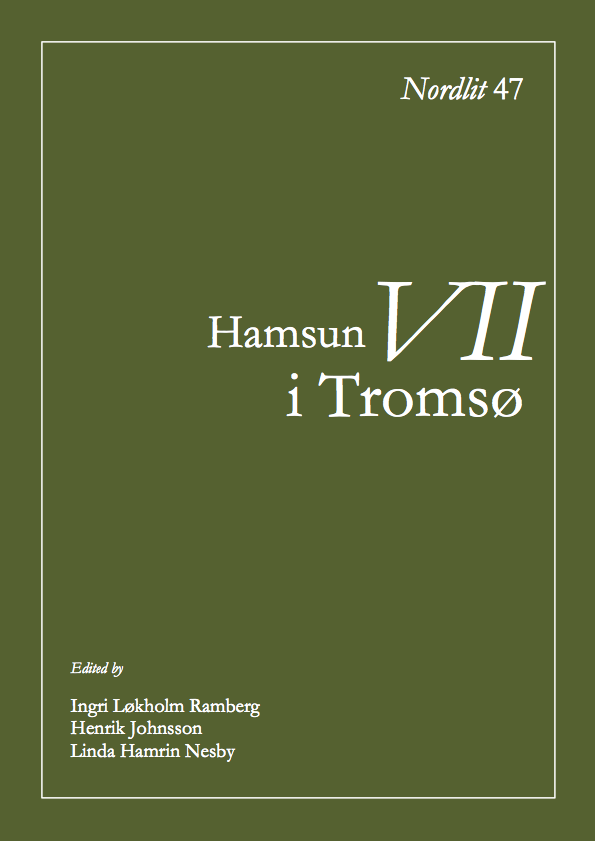Eros in the Hamsunian Male Figure
Fantasy Women in Knut Hamsun’s 1890s Literature
DOI:
https://doi.org/10.7557/13.5216Keywords:
woman in fantasy, gender, desire, Hamsunian maleAbstract
Using a psychoanalytic perspective, I explore Knut Hamsun’s novels, Sult (1890), Mysterier (1892), Pan (1894), and Victoria (1898) and focus on the power that the women in fantasy have over the different male protagonists, whom I term the Hamsunian male. Within each fantasy, the women either dominate or exert supernatural power over the Hamsunian male. By undertaking such an investigation, I examine how the desired women in fantasy differ from the main female characters, in so far as they portray the Hamsunian male’s desire that ranges from intense eroticism to fear and death. While my focus on the female characters in the Hamsunian male differs from the discussions concerning the main female characters, I note that such women comment on the depiction of the masculine gender in Hamsun’s work. Furthermore, the discussion shows the power of women in fantasy, thus questioning whether they should continue to be disregarded as only superficially feminine.
References
Buttry, Dolores. 2009. “The Muse and the Mimosa: Knut Hamsun’s Portrayal of the Inspired Artist,” In Germanic Notes and Reviews, 03/01/2009, 40(1).
Buttry, Dolores. 1998. “Pursuit and Confrontation: The Short Stories of Knut Hamsun,” In Scandinavian Studies, 06/01/1998, 70(2) . DOI: https://www.jstor.org/stable/40920042?seq=1
Cixous, Hélène. 1997. “Sorties,” in Feminisms. Eds. Sandra Kemp & Judith Squires. Oxford & New York: Oxford University Press. pp.231-235.
Hamsun, Knut. 1954a. Mysterier. Oslo: Gyldendal Norsk Forlag.
Hamsun, Knut. 1954b. Pan: Av løitnant Thomas Glahns papirer. Oslo: Gyldendal Norsk Forlag.
Hamsun, Knut. 1954c. Sult. Oslo: Gyldendal Norsk Forlag.
Hamsun, Knut. 1935. Victoria: En kjærligheds historie. Oslo: Gyldendal Norsk Forlag.
Kittang, Alte. 1984. Luft, vind, ingenting. Oslo: Glydendal Norsk Forlag.
Kolloen, Ingar Sletten. 2009. Dreamer and dissenter. Translated by Deborah Dawkin. London: Yale University Press
Lacan, Jacques. 2006. Desire and its Interpretations 1958-1959. Translated by Cormac Gallagher. http://www.lacaninireland.com.
Lacan, Jacques. 1998. The Four Fundamental Concepts of Psychoanalysis. Translated by Alan Sheridan, W.W. Norton & Company, Inc.
Moi, Toril. 1989. “Feminist, Female, Feminine,” in The Feminist Reader: Essays in Gender and the Politics of Literary Criticism. Eds. Catherine Belsey & Jane Moore. New York: Basil Blackwell. pp. 117-132.
Mulvey, Laura. 1999. “Visual Pleasure and Narrative Cinema.” Film Theory and Criticism: Introductory Readings. Eds. Leo Braudy and Marshal Cohen. New York: Oxford UP, 833-44.
Pulkki, Eveliina. 2018. “Failing Authorship in Knut Hamsun’s Sult (1890).” In Forum for Modern Language Studies, 06/12/2018, 54(3). https://doi.org/10.1093/fmls/cqy021
Von Schnurbein, Stefanie. "Failed Seductions: Crises of Masculinity in Knut Hamsun's "Pan" and Knut Faldbakken's "Glahn"." Scandinavian Studies 73, no. 2 (2001): 147-64. Accessed June 2, 2020. https://www.jstor.org/stable/40920298









